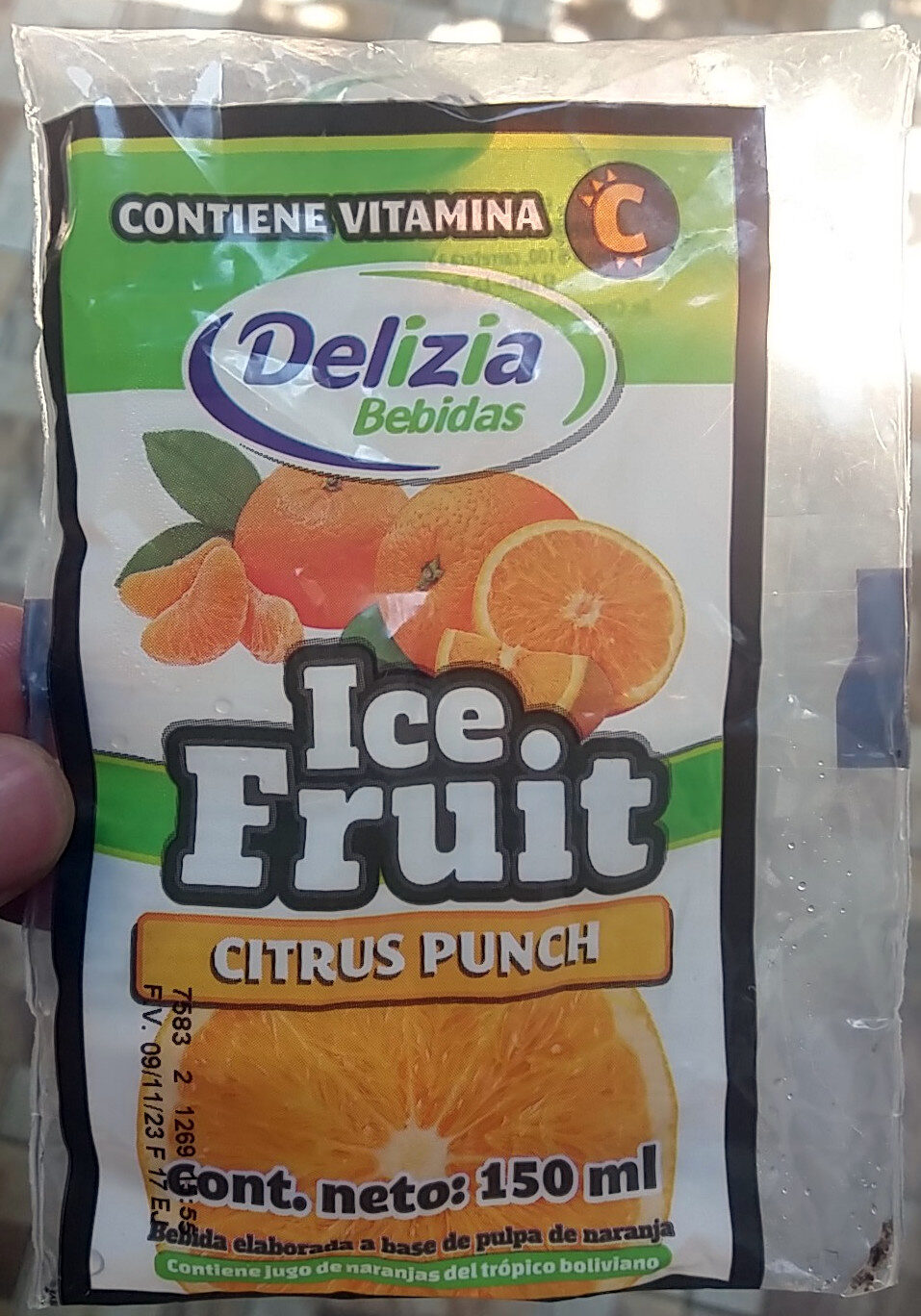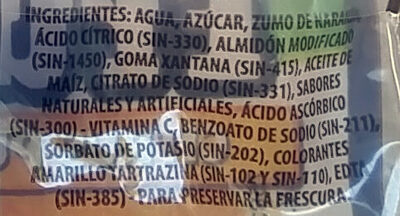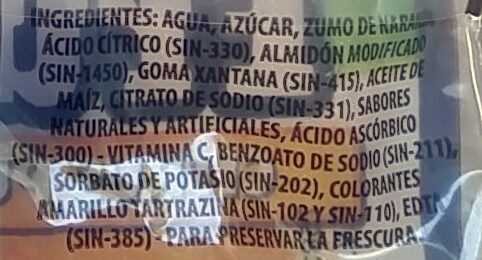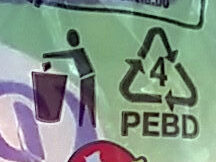Help us make food transparency the norm!
As a non-profit organization, we depend on your donations to continue informing consumers around the world about what they eat.
The food revolution starts with you!
Ice Fruit Citrus Punch - Delizia - 150 ml
Ice Fruit Citrus Punch - Delizia - 150 ml
Barcode: 7771224006286 (EAN / EAN-13)
Common name: bebida elaborada a base de pulpa de naranja.
Quantity: 150 ml
Categories: Plant-based foods and beverages, Beverages, Plant-based beverages, Fruit-based beverages, Juices and nectars, Fruit juices, Non-alcoholic beverages, Orange juices, Sweetened beverages
Labels, certifications, awards: Pasteurized, Rich in vitamin C, es:Hecho en Bolivia
Origin of the product and/or its ingredients: Zumo de Naranja del Trópico, Bolivia
Origin of ingredients: Bolivia
Manufacturing or processing places: El Alto, La Paz, Cotoca, Santa Cruz, Bolivia
Traceability code: 040103190001, 080103030003
Link to the product page on the official site of the producer: https://delizia.bo/product/ice-fruit-sac...
Stores: Delizia
Countries where sold: Bolivia
Matching with your preferences
Health
Ingredients
-
26 ingredients
Spanish: AGUA, AZÚCAR, ZUMO DE NARANJA, ÁCIDO CÍTRICO (SIN-330), ALMIDÓN MODIFICADO (SIN-1450), GOMA XANTANA (SIN-415), ACEITE DE MAÍZ, CITRATO DE SODIO (SIN-331), SABORES NATURALES Y ARTIFICIALES, ÁCIDO ASCÓRBICO (SIN-300 (VITAMINA C)), BENZOATO DE SODIO (SIN-211), SORBATO DE POTASIO (SIN-202), COLORANTES [AMARILLO TARTRAZINA (SIN-102), (SIN-110)], EDTA (SIN-385).
Food processing
-
Ultra processed foods
Elements that indicate the product is in the 4 - Ultra processed food and drink products group:
- Additive: E102 - Tartrazine
- Additive: E110 - Sunset yellow FCF
- Additive: E1450 - Starch sodium octenyl succinate
- Additive: E14XX - Modified Starch
- Additive: E415 - Xanthan gum
- Ingredient: Colour
Food products are classified into 4 groups according to their degree of processing:
- Unprocessed or minimally processed foods
- Processed culinary ingredients
- Processed foods
- Ultra processed foods
The determination of the group is based on the category of the product and on the ingredients it contains.
Additives
-
E102 - Tartrazine
Tartrazine: Tartrazine is a synthetic lemon yellow azo dye primarily used as a food coloring. It is also known as E number E102, C.I. 19140, FD&C Yellow 5, Acid Yellow 23, Food Yellow 4, and trisodium 1--4-sulfonatophenyl--4--4-sulfonatophenylazo--5-pyrazolone-3-carboxylate-.Tartrazine is a commonly used color all over the world, mainly for yellow, and can also be used with Brilliant Blue FCF -FD&C Blue 1, E133- or Green S -E142- to produce various green shades.Source: Wikipedia
-
E110 - Sunset yellow FCF
Sunset Yellow FCF: Sunset Yellow FCF -also known as Orange Yellow S, or C.I. 15985- is a petroleum-derived orange azo dye with a pH dependent maximum absorption at about 480 nm at pH 1 and 443 nm at pH 13 with a shoulder at 500 nm. When added to foods sold in the US it is known as FD&C Yellow 6; when sold in Europe, it is denoted by E Number E110.Source: Wikipedia
-
E202 - Potassium sorbate
Potassium sorbate (E202) is a synthetic food preservative commonly used to extend the shelf life of various food products.
It works by inhibiting the growth of molds, yeast, and some bacteria, preventing spoilage. When added to foods, it helps maintain their freshness and quality.
Some studies have shown that when combined with nitrites, potassium sorbate have genotoxic activity in vitro. However, potassium sorbate is generally recognized as safe (GRAS) by regulatory authorities.
-
E211 - Sodium benzoate
Sodium benzoate: Sodium benzoate is a substance which has the chemical formula NaC7H5O2. It is a widely used food preservative, with an E number of E211. It is the sodium salt of benzoic acid and exists in this form when dissolved in water. It can be produced by reacting sodium hydroxide with benzoic acid.Source: Wikipedia
-
E330 - Citric acid
Citric acid is a natural organic acid found in citrus fruits such as lemons, oranges, and limes.
It is widely used in the food industry as a flavor enhancer, acidulant, and preservative due to its tart and refreshing taste.
Citric acid is safe for consumption when used in moderation and is considered a generally recognized as safe (GRAS) food additive by regulatory agencies worldwide.
-
E331 - Sodium citrates
Sodium citrate: Sodium citrate may refer to any of the sodium salts of citrate -though most commonly the third-: Monosodium citrate Disodium citrate Trisodium citrateThe three forms of the salt are collectively known by the E number E331. Sodium citrates are used as acidity regulators in food and drinks, and also as emulsifiers for oils. They enable cheeses to melt without becoming greasy.Source: Wikipedia
-
E415 - Xanthan gum
Xanthan gum (E415) is a natural polysaccharide derived from fermented sugars, often used in the food industry as a thickening and stabilizing agent.
This versatile food additive enhances texture and prevents ingredient separation in a wide range of products, including salad dressings, sauces, and gluten-free baked goods.
It is considered safe for consumption even at high intake amounts.
Ingredients analysis
-
Palm oil free
No ingredients containing palm oil detected
Unrecognized ingredients: es:sabores-naturales-y-artificiales, es:amarillo-tartrazinaSome ingredients could not be recognized.
We need your help!
You can help us recognize more ingredients and better analyze the list of ingredients for this product and others:
- Edit this product page to correct spelling mistakes in the ingredients list, and/or to remove ingredients in other languages and sentences that are not related to the ingredients.
- Add new entries, synonyms or translations to our multilingual lists of ingredients, ingredient processing methods, and labels.
If you would like to help, join the #ingredients channel on our Slack discussion space and/or learn about ingredients analysis on our wiki. Thank you!
-
Vegan status unknown
Unrecognized ingredients: Sodium citrate, es:sabores-naturales-y-artificiales, Vitamin C, es:amarillo-tartrazinaSome ingredients could not be recognized.
We need your help!
You can help us recognize more ingredients and better analyze the list of ingredients for this product and others:
- Edit this product page to correct spelling mistakes in the ingredients list, and/or to remove ingredients in other languages and sentences that are not related to the ingredients.
- Add new entries, synonyms or translations to our multilingual lists of ingredients, ingredient processing methods, and labels.
If you would like to help, join the #ingredients channel on our Slack discussion space and/or learn about ingredients analysis on our wiki. Thank you!
-
Vegetarian status unknown
Unrecognized ingredients: Sodium citrate, es:sabores-naturales-y-artificiales, Vitamin C, es:amarillo-tartrazinaSome ingredients could not be recognized.
We need your help!
You can help us recognize more ingredients and better analyze the list of ingredients for this product and others:
- Edit this product page to correct spelling mistakes in the ingredients list, and/or to remove ingredients in other languages and sentences that are not related to the ingredients.
- Add new entries, synonyms or translations to our multilingual lists of ingredients, ingredient processing methods, and labels.
If you would like to help, join the #ingredients channel on our Slack discussion space and/or learn about ingredients analysis on our wiki. Thank you!
-
Details of the analysis of the ingredients
We need your help!
Some ingredients could not be recognized.
We need your help!
You can help us recognize more ingredients and better analyze the list of ingredients for this product and others:
- Edit this product page to correct spelling mistakes in the ingredients list, and/or to remove ingredients in other languages and sentences that are not related to the ingredients.
- Add new entries, synonyms or translations to our multilingual lists of ingredients, ingredient processing methods, and labels.
If you would like to help, join the #ingredients channel on our Slack discussion space and/or learn about ingredients analysis on our wiki. Thank you!
es: AGUA, AZÚCAR, ZUMO DE NARANJA, ÁCIDO CÍTRICO (e330), ALMIDÓN MODIFICADO (e1450), GOMA XANTANA (e415), ACEITE DE MAÍZ, CITRATO DE SODIO (e331), SABORES NATURALES y ARTIFICIALES, ÁCIDO ASCÓRBICO (e300 (VITAMINA C)), BENZOATO DE SODIO (e211), SORBATO DE POTASIO (e202), COLORANTES (AMARILLO TARTRAZINA (e102, e110)), EDTA (e385)- AGUA -> en:water - vegan: yes - vegetarian: yes - ciqual_food_code: 18066 - percent_min: 7.14285714285714 - percent_max: 100
- AZÚCAR -> en:sugar - vegan: yes - vegetarian: yes - ciqual_proxy_food_code: 31016 - percent_min: 0 - percent_max: 12
- ZUMO DE NARANJA -> en:orange-juice - vegan: yes - vegetarian: yes - ciqual_proxy_food_code: 2070 - percent_min: 0 - percent_max: 12
- ÁCIDO CÍTRICO -> en:e330 - vegan: yes - vegetarian: yes - percent_min: 0 - percent_max: 12
- e330 -> en:e330 - vegan: yes - vegetarian: yes - percent_min: 0 - percent_max: 12
- ALMIDÓN MODIFICADO -> en:modified-starch - vegan: yes - vegetarian: yes - ciqual_proxy_food_code: 9510 - percent_min: 0 - percent_max: 12
- e1450 -> en:e1450 - vegan: yes - vegetarian: yes - percent_min: 0 - percent_max: 12
- GOMA XANTANA -> en:e415 - vegan: yes - vegetarian: yes - percent_min: 0 - percent_max: 12
- e415 -> en:e415 - vegan: yes - vegetarian: yes - percent_min: 0 - percent_max: 12
- ACEITE DE MAÍZ -> en:corn-oil - vegan: yes - vegetarian: yes - from_palm_oil: no - ciqual_food_code: 17190 - percent_min: 0 - percent_max: 12
- CITRATO DE SODIO -> en:sodium-citrate - percent_min: 0 - percent_max: 12
- e331 -> en:e331 - vegan: yes - vegetarian: yes - percent_min: 0 - percent_max: 12
- SABORES NATURALES y ARTIFICIALES -> es:sabores-naturales-y-artificiales - percent_min: 0 - percent_max: 11.1111111111111
- ÁCIDO ASCÓRBICO -> en:e300 - vegan: yes - vegetarian: yes - percent_min: 0 - percent_max: 10
- e300 -> en:e300 - vegan: yes - vegetarian: yes - percent_min: 0 - percent_max: 10
- VITAMINA C -> en:vitamin-c - percent_min: 0 - percent_max: 10
- e300 -> en:e300 - vegan: yes - vegetarian: yes - percent_min: 0 - percent_max: 10
- BENZOATO DE SODIO -> en:e211 - vegan: yes - vegetarian: yes - percent_min: 0 - percent_max: 9.09090909090909
- e211 -> en:e211 - vegan: yes - vegetarian: yes - percent_min: 0 - percent_max: 9.09090909090909
- SORBATO DE POTASIO -> en:e202 - vegan: yes - vegetarian: yes - percent_min: 0 - percent_max: 8.33333333333333
- e202 -> en:e202 - vegan: yes - vegetarian: yes - percent_min: 0 - percent_max: 8.33333333333333
- COLORANTES -> en:colour - percent_min: 0 - percent_max: 7.69230769230769
- AMARILLO TARTRAZINA -> es:amarillo-tartrazina - percent_min: 0 - percent_max: 7.69230769230769
- e102 -> en:e102 - vegan: yes - vegetarian: yes - percent_min: 0 - percent_max: 7.69230769230769
- e110 -> en:e110 - vegan: yes - vegetarian: yes - percent_min: 0 - percent_max: 3.84615384615385
- AMARILLO TARTRAZINA -> es:amarillo-tartrazina - percent_min: 0 - percent_max: 7.69230769230769
- EDTA -> en:e385 - vegan: yes - vegetarian: yes - percent_min: 0 - percent_max: 7.14285714285714
- e385 -> en:e385 - vegan: yes - vegetarian: yes - percent_min: 0 - percent_max: 7.14285714285714
Nutrition
-
Bad nutritional quality
⚠ ️Warning: the amount of fruits, vegetables and nuts is not specified on the label, it was estimated from the list of ingredients: 6This product is considered a beverage for the calculation of the Nutri-Score.
Positive points: 0
- Proteins: 0 / 5 (value: 0, rounded value: 0)
- Fiber: 0 / 5 (value: 0, rounded value: 0)
- Fruits, vegetables, nuts, and colza/walnut/olive oils: 0 / 10 (value: 6, rounded value: 6)
Negative points: 16
- Energy: 8 / 10 (value: 231, rounded value: 231)
- Sugars: 8 / 10 (value: 12, rounded value: 12)
- Saturated fat: 0 / 10 (value: 0, rounded value: 0)
- Sodium: 0 / 10 (value: 37.3, rounded value: 37.3)
The points for proteins are not counted because the negative points are greater or equal to 11.
Nutritional score: (16 - 0)
Nutri-Score:
-
Nutrient levels
-
Fat in low quantity (0%)
What you need to know- A high consumption of fat, especially saturated fats, can raise cholesterol, which increases the risk of heart diseases.
Recommendation: Limit the consumption of fat and saturated fat- Choose products with lower fat and saturated fat content.
-
Sugars in high quantity (12%)
What you need to know- A high consumption of sugar can cause weight gain and tooth decay. It also augments the risk of type 2 diabetes and cardio-vascular diseases.
Recommendation: Limit the consumption of sugar and sugary drinks- Sugary drinks (such as sodas, fruit beverages, and fruit juices and nectars) should be limited as much as possible (no more than 1 glass a day).
- Choose products with lower sugar content and reduce the consumption of products with added sugars.
-
Salt in low quantity (0.0933%)
What you need to know- A high consumption of salt (or sodium) can cause raised blood pressure, which can increase the risk of heart disease and stroke.
- Many people who have high blood pressure do not know it, as there are often no symptoms.
- Most people consume too much salt (on average 9 to 12 grams per day), around twice the recommended maximum level of intake.
Recommendation: Limit the consumption of salt and salted food- Reduce the quantity of salt used when cooking, and don't salt again at the table.
- Limit the consumption of salty snacks and choose products with lower salt content.
-
-
Nutrition facts
Nutrition facts As sold
for 100 g / 100 mlAs sold
per serving (150 ml)Compared to: Orange juices Energy 231 kj
(55 kcal)347 kj
(83 kcal)+27% Energy from fat 0 kj
(0 kcal)0 kj
(0 kcal)Fat 0 g 0 g -100% Saturated fat - - Carbohydrates 13.3 g 20 g +38% Sugars 12 g 18 g +32% Fiber - - Proteins 0 g 0 g -100% Salt 0.093 g 0.14 g +1,393% Vitamin C (ascorbic acid) 20 mg 30 mg (50 % DV) -26% Fruits‚ vegetables‚ nuts and rapeseed‚ walnut and olive oils (estimate from ingredients list analysis) 6 % 6 %
Environment
-
Eco-Score C - Moderate environmental impact
⚠ ️Select a country in order to include the full impact of transportation.The Eco-Score is an experimental score that summarizes the environmental impacts of food products.→ The Eco-Score was initially developped for France and it is being extended to other European countries. The Eco-Score formula is subject to change as it is regularly improved to make it more precise and better suited to each country.Life cycle analysis
-
Average impact of products of the same category: B (Score: 63/100)
Category: Mixed fruits juice, orange based, multivitamin
Category: Mixed fruits juice, orange based, multivitamin
- PEF environmental score: 0.10 (the lower the score, the lower the impact)
- including impact on climate change: 1.08 kg CO2 eq/kg of product
Stage Impact Agriculture
19.9 %Processing
42.4 %Packaging
14.5 %Transportation
19.1 %Distribution
4.1 %Consumption
0.0 %
Bonuses and maluses
-
Origins of ingredients with a high impact
Malus: -5
Environmental policy: -5
Transportation: 0
Origin of the product and/or its ingredients % of ingredients Impact Bolivia 100 %High
-
Packaging with a medium impact
Malus: -8
Shape Material Recycling Impact 1 Bag LDPE 4 - Low-density polyethylene Recycle High
Eco-Score for this product
-
Impact for this product: C (Score: 50/100)
Product: Ice Fruit Citrus Punch - Delizia - 150 ml
Life cycle analysis score: 63
Sum of bonuses and maluses: -13
Final score: 50/100
-
Carbon footprint
-
Equal to driving 0.6 km in a petrol car
108 g CO² per 100g of product
The carbon emission figure comes from ADEME's Agribalyse database, for the category: Mixed fruits juice, orange based, multivitamin (Source: ADEME Agribalyse Database)
Stage Impact Agriculture
5.9 %Processing
66.5 %Packaging
6.3 %Transportation
20.0 %Distribution
1.3 %Consumption
0.0 %
Packaging
-
Packaging with a medium impact
-
Packaging parts
1 x Bag (LDPE 4 - Low-density polyethylene)
-
Packaging materials
Material % Packaging weight Packaging weight per 100 g of product Plastic
-
Transportation
-
Origins of ingredients
Origins of ingredients with a high impact
Origin of the product and/or its ingredients % of ingredients Impact Bolivia 100 %High
Report a problem
-
Incomplete or incorrect information?
Category, labels, ingredients, allergens, nutritional information, photos etc.
If the information does not match the information on the packaging, please complete or correct it. Open Food Facts is a collaborative database, and every contribution is useful for all.












